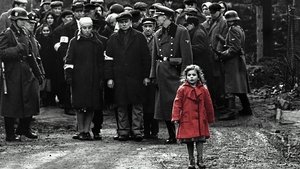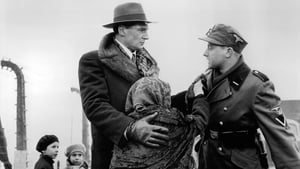Contact: info@alwanfilm.com
Video Sources 0 Views

Synopsis
Review: Schindler’s List 1993 Colorized – A Cinematic Masterpiece and the Ethics of Colorization

Introduction
In the annals of cinema, few films possess the haunting power and historical significance of Steven Spielberg’s “Schindler’s List” (1993). This film, a stark and unflinching portrayal of the Holocaust, chronicles the extraordinary true story of Oskar Schindler, a German industrialist who saved over a thousand Jewish lives during one of humanity’s darkest chapters. Shot in stark black and white, the film’s aesthetic choice serves as a powerful narrative tool, immersing the audience in the grim reality of the era. However, the notion of releasing a colorized version has ignited debates within the film community about the ethics of altering such a poignant and historically significant work. In this article, we explore the impact of this film, the significance of its black-and-white presentation, and the potential implications of colorization on its legacy.
Check The Full Colorized Movies List
Check Our Colorized Movies Trailer Channel
Understanding Schindler’s List 1993 Colorized: Director, Cast, and Genre
“Schindler’s List” is the magnum opus of Steven Spielberg, one of the most influential directors in the history of cinema. Spielberg, known for his ability to craft both blockbuster spectacles and deeply personal films, approached “Schindler’s List” with a solemn dedication to historical accuracy and emotional truth. The film is anchored by the exceptional performances of its lead actors: Liam Neeson as Oskar Schindler, Ralph Fiennes as the chilling SS officer Amon Göth, and Ben Kingsley as Schindler’s Jewish accountant, Itzhak Stern.
This historical drama is a searing portrayal of the Holocaust, examining the moral complexities of human behavior in the face of unimaginable atrocity. Spielberg’s meticulous direction, coupled with the haunting performances of his cast, transforms “Schindler’s List” into more than just a film; it is a historical document, a cinematic memorial to the victims of the Holocaust.
Exploring the World of Schindler’s List 1993 Colorized: Plot and Characters
“Schindler’s List” follows the transformation of Oskar Schindler, a businessman and member of the Nazi party, who initially seeks to profit from the war by exploiting Jewish labor. However, as he witnesses the horrors inflicted upon the Jewish population, Schindler’s motives shift from self-interest to a selfless commitment to saving as many lives as possible.
The narrative is a journey through the hellish landscape of the Holocaust, depicted with unflinching realism. Key moments include the liquidation of the Kraków ghetto, where the infamous scene of the “girl in the red coat” symbolizes the loss of innocence and the inhumanity of the genocide. The film’s characters, from the morally ambiguous Schindler to the monstrous Göth, provide a complex portrait of humanity, where good and evil are constantly at war.
The Art of Film Colorization
Colorization, the process of adding color to black and white films, has been a topic of significant debate since its inception. While some see it as a way to rejuvenate older films and make them more accessible to modern audiences, others argue that it often compromises the original artistic vision of the filmmakers.
In the case of “Schindler’s List,” the discussion around colorization takes on additional weight. Spielberg’s decision to shoot the film in black and white was not merely a stylistic choice but a deliberate attempt to evoke the period’s documentary footage, thereby grounding the film in the stark reality of the Holocaust. Any attempt to colorize the film would not only alter its aesthetic but could also dilute its emotional and historical impact.
Early Colored Films: A Brief History
The history of colorization in cinema dates back to the early 20th century when filmmakers experimented with tinting and hand-painting individual frames. The advent of Technicolor in the 1930s brought vibrant color to the big screen, changing the visual landscape of cinema forever. However, the practice of colorizing existing black and white films didn’t gain traction until the late 20th century, often meeting with resistance from purists who believed it compromised the integrity of the original works.
As colorization technology advanced, debates intensified over its use, particularly in films where the original black and white presentation was a conscious artistic choice. The controversy often centers around the question of whether colorization enhances the storytelling or detracts from the original vision of the filmmakers.
Schindler’s List 1993 and the Concept of a Colorized Version
The notion of releasing a colorized version of “Schindler’s List” is controversial, to say the least. Spielberg’s decision to shoot the film in black and white was a deliberate homage to the documentary footage of the era, aiming to present the Holocaust in its raw and unvarnished reality. The stark monochrome palette strips away any romanticism, forcing viewers to confront the horror of the events depicted.
A colorized version of “Schindler’s List” would undoubtedly change the way the film is perceived. The black and white imagery is integral to its narrative power, evoking the bleakness of the Holocaust and the moral gravity of Schindler’s actions. Adding color to this film risks undermining its historical authenticity and emotional resonance.
The Debate Over Film Colorization
The colorization of classic black and white films is a contentious issue within the film community. Proponents argue that colorization can bring new life to older films, making them more appealing to contemporary audiences who may be less accustomed to black and white cinema. They claim that colorization can also enhance the storytelling by providing a more immersive visual experience.
However, critics of colorization argue that it often distorts the original artistic intent, particularly in films where the choice of black and white was a deliberate narrative decision. They contend that colorization can strip away the subtlety and depth of the original cinematography, replacing the carefully crafted contrasts and shadows with an artificial palette that can feel jarring and out of place.
In the case of “Schindler’s List,” the argument against colorization is particularly strong. Spielberg’s use of black and white is not just a stylistic choice but a fundamental aspect of the film’s narrative and emotional impact. The film’s stark monochrome presentation is crucial to its ability to convey the horror and inhumanity of the Holocaust, and altering this aspect would fundamentally change the viewing experience.
Examining Schindler’s List 1993 as a Potentially Colorized Film
If “Schindler’s List” were to be colorized, the impact on the viewing experience would be profound. The black and white cinematography of the film is one of its most powerful elements, creating a visual language that speaks to the historical gravity of the Holocaust. The use of color could potentially detract from the film’s emotional intensity, reducing the stark contrasts and the symbolic use of shadows and light that are integral to its narrative.
Moreover, the few instances of color in the film, such as the “girl in the red coat,” serve as powerful visual metaphors. These moments stand out precisely because they break the monochrome palette, drawing the viewer’s attention to key aspects of the story. A fully colorized version of the film would likely diminish the impact of these moments, making them less poignant and reducing their symbolic power.
Influence and Legacy: Schindler’s List 1993 Colorized’s Impact on Cinema
“Schindler’s List” has had an immeasurable impact on cinema and society at large. Upon its release, the film was hailed as a cinematic masterpiece, earning seven Academy Awards, including Best Picture and Best Director for Spielberg. It has been credited with raising awareness of the Holocaust, particularly among younger generations, and has been used as an educational tool in classrooms around the world.
The film’s influence extends beyond its immediate impact, inspiring countless filmmakers to tackle difficult and important subjects with honesty and integrity. Spielberg’s approach to “Schindler’s List” set a new standard for historical dramas, demonstrating that films can be both artistically compelling and socially significant.
Director’s Cinematic Legacy: Beyond Schindler’s List 1993 Colorized
Steven Spielberg’s legacy as a filmmaker extends far beyond “Schindler’s List.” Over the course of his career, Spielberg has directed a wide range of films, from blockbuster hits like “Jaws” and “Jurassic Park” to more intimate, character-driven dramas like “The Color Purple” and “Saving Private Ryan.” His versatility as a director, combined with his keen storytelling instincts, has made him one of the most successful and respected filmmakers in the history of cinema.
Spielberg’s work on “Schindler’s List” marked a significant turning point in his career, showcasing his ability to tackle serious, complex subjects with the same skill and sensitivity that he brought to his more commercially oriented projects. The film solidified his reputation as a director capable of creating profound, socially relevant works that resonate with audiences on a deep emotional level.
Themes Explored in Schindler’s List 1993 Colorized
“Schindler’s List” delves into some of the most profound themes in human history, exploring the nature of evil, the capacity for good, and the moral complexities of survival during one of the darkest periods in human history. The film examines the choices people make in the face of atrocity and the ways in which those choices define their humanity.
Central to the film’s narrative is the theme of moral transformation. Oskar Schindler begins the story as a self-serving businessman, more interested in profits than people. However, as he witnesses the brutality of the Nazi regime and the suffering of the Jewish people, he undergoes a profound transformation, ultimately risking his life and fortune to save others.
Another significant theme in the film is the concept of memory and history. “Schindler’s List” serves as a reminder of the importance of remembering the past, not only to honor the victims of the Holocaust but also to prevent such atrocities from occurring again. The film’s stark portrayal of the Holocaust is a powerful statement on the need to confront and acknowledge the darkest chapters of history.
Reception and Controversy Surrounding Schindler’s List 1993 Colorized
“Schindler’s List” was met with widespread critical acclaim upon its release, with many critics praising its unflinching portrayal of the Holocaust and its powerful performances. The film’s stark realism and emotional depth struck a chord with audiences, earning it a place among the most important films of the 20th century.
However, the idea of colorizing “Schindler’s List” has sparked controversy among critics and audiences alike. Many argue that altering the film’s black and white presentation would undermine its historical authenticity and emotional impact. Spielberg himself has expressed opposition to the idea of colorizing the film, viewing it as an essential aspect of its narrative and artistic integrity.
Where to Watch Schindler’s List 1993 Colorized Online
For those who have not yet experienced the profound impact of “Schindler’s List,” the film is available on a variety of streaming platforms, ensuring that it remains accessible to audiences around the world. Whether in its original black and white format or a potential colorized version, “Schindler’s List” is a film that demands to be seen and remembered.
FAQs About Schindler’s List 1993 Colorized
Common questions about “Schindler’s List” often revolve around its historical accuracy, the significance of its black and white cinematography, and the moral implications of the story it tells. Addressing these questions can help viewers gain a deeper understanding of the film’s impact and the importance of its themes.
Q: How historically accurate is “Schindler’s List”?
A: While “Schindler’s List” is based on real events and people, Spielberg took some artistic liberties for dramatic effect. However, the film is widely regarded as one of the most historically accurate portrayals of the Holocaust in cinema.
Q: Why was “Schindler’s List” filmed in black and white?
A: Spielberg chose to shoot the film in black and white to evoke the period’s documentary footage and to create a visual language that reflected the grim reality of the Holocaust. The stark monochrome palette is integral to the film’s emotional and historical impact.
Q: What is the significance of the “girl in the red coat”?
A: The “girl in the red coat” is one of the few instances of color in the film, symbolizing the loss of innocence and the human cost of the Holocaust. Her red coat stands out in the black and white film, drawing attention to the individual amidst the mass suffering.
Conclusion
“Schindler’s List” is a cinematic masterpiece that transcends the boundaries of film, serving as both a powerful narrative and a historical document. The black and white cinematography is not merely a stylistic choice but a fundamental element of the film’s narrative and emotional power. The idea of colorizing such a work raises important questions about the ethics of altering a film’s original presentation, particularly when that presentation is so closely tied to its historical and artistic significance.
As we continue to engage with films like “Schindler’s List,” it is crucial to consider the intentions of the filmmakers and the impact that changes like colorization can have on a film’s legacy. In the case of “Schindler’s List,” the stark, haunting beauty of its black and white imagery serves as a powerful reminder of the horrors of the past, urging us to remember and to learn from history.




















